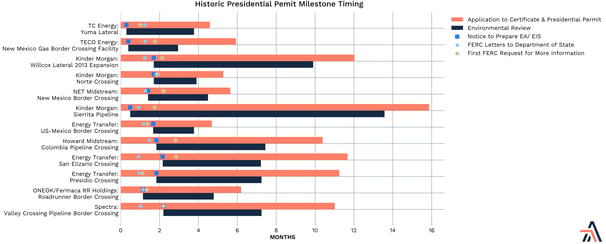A Tale of Two Chairmen: Presidents’ Day Presidential Permitting
Originally published for customers February 22, 2023
What’s the issue?
The Saguaro Connector Pipeline Project reached a key milestone in the Presidential Permitting process on Thursday, but perhaps the most important milestone will be the determination of whether it receives an Environmental Assessment or an Environmental Impact Statement.
Why does it matter?
There is rising interest and opportunity in border crossing projects given the current appetite for gas in Mexico. For companies looking to capitalize on this opportunity, a key factor in the project’s go/no-go decision will be the length of schedule due to environmental report type.
What’s our view?
The determination of the environmental report type will have a large impact on the length of time it will take to receive a permit, and we will be watching the direction of Acting Chairman Phillips in the coming months. The culmination of FERC factors affecting project development are at a critical inflection point — either leading to a return to historical normalcy or the potential for significant delays similar to what we saw under former Chairman Glick.
The Presidential Permit process for pipelines, created by Executive Order 10485, is a process by which companies can apply and be approved for facilities crossing the border of the United States. This process has been a heavily covered topic over the past decade as the two most recent presidential administrations have used it to determine the fate of Keystone XL Pipeline; most recently, President Biden revoked the Keystone XL Pipeline permit in his first few days as president.
In Thursday’s FERC meeting, ONEOK’s Saguaro Connector Pipeline Project, a border crossing project filed in December of 2022, achieved an important milestone in the Presidential Permitting process as FERC issued letters to the Department of State and the Department of Defense recommending approval of the application.
Border crossing projects have been rare in recent years, but with Mexico’s President Andrés Manuel López Obrador announcing that he plans to dismantle oil and gas reforms — by and large seen as a net positive for gas imports into the country — we will likely start to see more of them. In addition, Mexico may now be the preferred location for LNG facilities assuming liquefaction capacity can get across the border from the states. In today’s ArView, we look at the historical timing of cross-border projects and help identify how the current FERC may administer the permitting process.
If history repeats itself and project development returns to the status quo, we expect the application process for a border crossing project to take between five and nine months; however, we don’t have empirical evidence yet to project how Acting Chairman Phillips might handle Presidential Permits. As we discussed in Timing of Restarts for Keystone, El Paso and Freeport and Some Good News for MVP, it is welcome news that Acting Chairman Phillips has directed FERC staff to conduct Environmental Assessment Reports (EA) rather than Environmental Impact Statements (EIS) on three recent projects. However, Saguaro has yet to receive a determination of environmental report type, and it received a Notice of Scoping period for environmental issues on February 3, which may indicate the Commission may be heading towards an EIS. Of the twelve Mexico border crossing projects since 2008, only one required a full EIS – Kinder Morgan’s 59-mile Sierrita Pipeline Project. This project was an outlier compared to the other 11 because the entire project, including the associated pipeline, was filed with FERC, instead of just the border crossing portion. The other border crossing projects were all much smaller, with an average length of 0.72 miles. Sierrita also responded to four times as many data requests during the application process.

Historically, the application process for border crossing projects has been fairly quick, with a median time of 8.3 months, and many projects received a Certificate and Presidential Permit in fewer than six months. This is primarily because the border crossing permit considers just the portion of the project at the border itself.
The feeder pipelines are mostly intrastate and not subject to FERC jurisdiction. Typically, state level regulators such as the Texas Railroad Commission regulate the associated pipeline projects. Due to the fact that the border crossing portion is so small, FERC almost always requires an EA rather than an EIS, leading to review times of less than five months. That said, the most recent Presidential Permit project received its certificate in 2017. The last Presidential Permit approved under a FERC chairman appointed by a Democratic president was Energy Transfer’s Trans-Pecos Pipeline in 2015, when FERC opted for an EA after hundreds of opposition comments requesting an EIS. This was carefully examined by FERC and is mentioned heavily throughout the order given to Energy Transfer, ultimately confirming that the need was not present for an EIS. Because FERC has no jurisdiction over the associated pipeline, precedent would be for Acting Chairman Phillips to opt for an EA.
Moving forward, environmental reviews will have the greatest variability in projecting schedules for border crossing projects. None were filed under former Chairman Glick’s chairmanship, and Saguaro is the first under Acting Chairman Phillips. We’ll be closely monitoring these and all other FERC projects to help customers have the best possible datasets for impactful benchmarking and decision making.